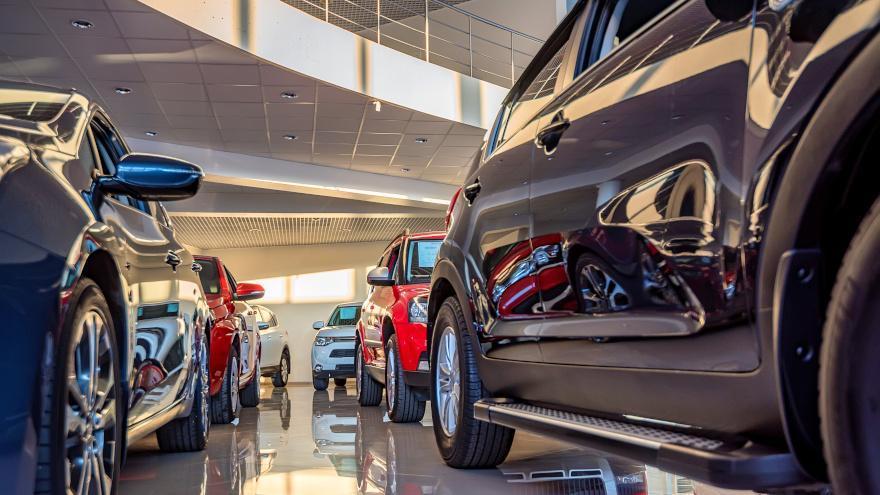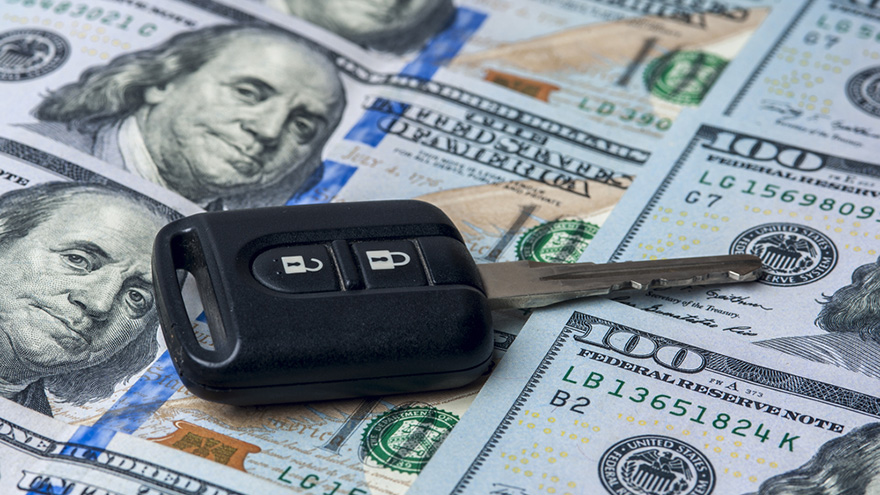Amid some sequential slowing, wholesale vehicle prices closed 2020 with some strength, according to Auto Remarketing’s examination of various indices from around the industry.
Starting with the Manheim Used Vehicle Value Index, that came in at 161.1 for December. While wholesale prices were off 0.59% from November (mix-, mileage- and seasonally adjusted), last month’s index was 14.2% higher year-over-year.
And the index has now gone five straight months above 160, a streak that includes the record high of 163.7 in August
Breaking it down by a few select segments, pickup prices climbed 28.2% year-over-year in December, according to the Manheim index, and luxury cars were up 20.8%. SUV/CUV prices were up 11.3%, van prices were up 4.1% and compact car prices climbed 2.1%. There was a 0.7% dip in midsize car prices.
“It is clear that there has been a material step change in used-vehicle values whether you look at it from a pure price trend or we gauge used values against new,” Cox Automotive chief economist Jonathan Smoke said in a news release.
“It will be important going forward to assess if at any point this might imply a correction could happen when the imbalance is no longer so heavily weighted towards demand,” Smoke said. “As we expected, what we have been seeing so far shows no evidence of a correction or one on the horizon.
“Supply remains tight, and demand remains strong despite some softening this fall. While January is a bit of a wild card for the economy, as we get closer to the spring, conditions look to be very favorable for used vehicle values.”
Next up, Black Book’s Used Vehicle Retention Index was down 1.8 points from November, but soared 15.5 points from December 2019, coming in at 128.8.
“The seasonally adjusted Retention Index has remained relatively stable since August,” Black Book senior vice president of data science Alex Yurchenko said in a news release. “Nevertheless, due two record-setting summer months, the year ended with a 15.5-point (or 13.7%) year-over-year change in the Index.
“In fact, only the minivan segment did not have a year-over-year increase in the Index.”
Drilling down further, J.D. Power Valuation Services indicated in a Used Market Update from Friday that wholesale auction prices dipped 2% week-over-week for the period ending Dec. 27, but then climbed 1.6% the week ending Jan. 3.
That was the largest week-over-week gain in nearly a month, J.D. Power indicated.
With that movement, the most recent wholesale price reading is 22% stronger than the April trough. And they are up 4% from the beginning of March, prior to the pandemic, according to the analysis.
In Black Book’s Weekly Automotive Market Update released Tuesday, the company indicated that wholesale prices have declined “at the seasonally normal rate” for 18 straight weeks.
Overall, they were down 0.8% last week, compared to a 0.46% decline the prior week and the historical average of 0.6%, according to Black Book.
Cars were down 0.91% and trucks/SUVs were down 0.74%.
Black Book did note in the analysis that, “2020 ended with used wholesale prices at the elevated level. With economic patterns (including automotive market) driven by the pandemic, normal seasonal patterns (e.g., 2019 calendar year) in the wholesale market were not observed for most of the year. We saw a similar picture in 2009, at the end of the Great Recession. The question still remains whether we will go back to normal seasonality in 2021.”
Wholesale vehicle prices remain at an elevated level in the first half of November, according to a mid-month reading of the Manheim Used Vehicle Value Index.
Prices could slow in these last few weeks of 2020, according to analysis from J.D. Power's David Paris, but are expected to end the year stronger than where they were before COVID-19.
Starting with Manheim's report, the mid-month index was up 16.9% year-over-year, coming in at 162.5.
Wholesale prices in the month’s first half were up 0.3% (on a mix-, mileage- and seasonally adjusted basis) from an already strong October.
Manheim pointed out in an analysis of the index that, “the non-seasonally adjusted monthly change was -0.9%, which was closer to what we have been seeing in weekly price trends. The difference between the two metrics is largely a result of the seasonal adjustment, which expects a decline in November. For example, across the full history of the Manheim Index, November has averaged a 0.6% monthly decline in the NSA price. But over the last five years, that decline has been 1.0%.”
Prices in segments like pickups (up 29.1%) and luxury cars (up 22.4%) were up even higher than the industry average (up 16.9%) when compared to mid-November 2019, according to Manheim.
SUV/CUV prices climbed 14.5% in the first half of the month, compact cars were up 7.3%, vans were up 5.8% and midsize cars were up 1.4%.
Rental risk prices climbed 2.5% year-over-year in the month’s first half, but dipped 3% month-over-month.
Looking at weekly trends, the J.D. Power Valuation Services said in a report released Thursday that the week ending Nov. 8 was the 12th straight time that wholesale auction prices were down from the prior week's.
The company’s Weekly Wholesale Auction Price Index was at 106.1. that week, down from 107.1 the prior week.
After peaking in August, wholesale prices have fallen 8%, J.D. Power said. However, they’re up 25% since bottoming out in April and have climbed 6% since March, according to this post from Paris.
“Despite a slowing used market, wholesale prices remain strong. Prices are expected to continue to move lower through the remaining weeks of November and December as pent-up demand has been satisfied and pandemic-related macro-economic headwinds increase. By year's end, prices are expected to be greater than pre-virus levels,” Paris said.
He cautions that a number of unknowns on a macro-economic level could affect used-price movements.
“It is important to note, however, that while the outlook is relatively optimistic, there remains a great deal of uncertainty surrounding the effect of new virus outbreaks, the potential for another round of federal stimulus and overall employment conditions,” Paris said. “Given these unknowns, a heightened degree of market volatility should be expected.”
Just like cream and sugar cuts the bite of strong coffee, KAR Auction Services chief economist Tom Kontos noticed wholesale price movements of cars versus trucks unfolded similarly in February to produce the overall reading.
And the movements happened in part to what’s occurring “upstream” versus “downstream.”
According to ADESA Analytical Services’ monthly analysis of wholesale used-vehicle prices by vehicle model class, wholesale used-vehicle prices in February averaged $10,775. The reading represented an uptick of 0.1 percent compared to January and 0.6 percent relative to February of last year.
On average, Kontos explained that car segment prices were down both month-over-month and year-over-year, while the opposite was true for trucks.
Average wholesale prices were relatively flat in February, as opposing forces largely canceled each other out,” he said in his latest installment of the Kontos Kommentary.
“To be more specific, overall car price declines were more than offset by truck price gains, and off-lease price strength was largely offset by softer prices elsewhere,” Kontos continued. “Within the off-lease segment, the ‘take-rate’ of midsize cars purchased upstream may be higher than that of midsize SUV/crossovers, which is leaving fewer late-model midsize cars in the lanes and an abundance of midsize SUV/crossovers.”
To illustrate his assertions further, Kontos went back to a main part of his monthly updates — examining fleet/lease sales of 3-year-old midsize sedans and midsize SUV/crossovers with less than 45,000 miles.
“When holding constant for sale type, model-year age, mileage, and model class segment — using criteria that characterize off-lease units — prices were up significantly on a year-over-year basis for midsize cars but down significantly for midsize SUV/CUVs,” Kontos said.
Prices for those specific cars jumped $411 to $11,967 while prices for those particular utilities slid by $471 to $20,102.
“A possible explanation for the strength of off-lease midsize car prices is that more off-lease cars are being bought ‘upstream,’ that is, in online-only sales from dealer lots and marshalling yards,” Kontos said. “So, auctions may be seeing a relative scarcity of late-model midsize cars.
“On the other hand, there may be an abundance of midsize trucks at auction as more of these vehicles are making it ‘downstream’ to physical auction lots,” he continued.
Kontos went on to mention average wholesale prices for used vehicles remarketed by manufacturers in February rose 1.7 percent month-over-month but dropped 1.8 percent year-over-year.
He noted prices for fleet/lease consignors ticked 0.4 percent lower sequentially but jumped 4.6 percent year-over-year.
Furthermore, Kontos said average prices for dealer consignors in February edged 0.4 percent versus January and 0.3 percent relative to February of last year.
Kontos closed his analysis by looking at used-vehicle deliveries based on National Automobile Dealers Association data. Retail used-vehicle sales by franchised dealers, and independent dealers each increased 4.0 percent year-over-year in February.
ADESA Wholesale Used-Vehicle Price Trends
| |
Average |
Price |
($/Unit) |
Latest |
Month Versus |
| |
Febuary 2019 |
January 2019 |
February 2018 |
Prior Month |
Prior Year |
| |
|
|
|
|
|
| Total All Vehicles |
$10,775 |
$10,761 |
$10,707 |
0.1% |
0.6% |
| |
|
|
|
|
|
| Total Cars |
$8,339 |
$8,374 |
$8,609 |
–0.4% |
-3.1% |
| Compact Car |
$6,484 |
$6,495 |
$6,563 |
-0.2% |
-1.2% |
| Midsize Car |
$7,352 |
$7,394 |
$7,702 |
-0.6% |
-4.6% |
| Full-size Car |
$7,780 |
$7,729 |
$7,554 |
0.7% |
3.0% |
| Luxury Car |
$12,663 |
$12,771 |
$13,132 |
-1.1% |
-3.8% |
| Sporty Car |
$13,412 |
$13,044 |
$14,079 |
2.8% |
-4.7% |
| |
|
|
|
|
|
| Total Trucks |
$12,820 |
$12,793 |
$12,647 |
0.2% |
1.4% |
| Minivan |
$8,367 |
$8,496 |
$8,714 |
-1.5% |
-4.0% |
| Full-size Van |
$12,287 |
$12,585 |
$13,032 |
-2.4% |
-5.7% |
| Compact SUV/CUV |
$11,095 |
$10,962 |
$10,638 |
1.2% |
4.3% |
| Midsize SUV/CUV |
$11,234 |
$11,192 |
$11,083 |
0.4% |
1.4% |
| Full-size SUV/CUV |
$13,628 |
$13,957 |
$13,411 |
-2.4% |
1.6% |
| Luxury SUV/CUV |
$17,788 |
$17,613 |
$18,101 |
1.0% |
-1.7% |
| Compact Pickup |
$9,692 |
$9,734 |
$8,977 |
-0.4% |
8.0% |
| Full-size Pickup |
$15,662 |
$15,552 |
$15,635 |
0.7% |
0.2% |
Source: ADESA Analytical Services.
Depreciation accounts for 32.9 percent of the total cost to own and operate a vehicle over the past 12 months. That is according to a “2019 Cost of Vehicle Ownership Trend Report” from vehicle management and reimbursement platform, Motus.
Another finding of the report was that in 2018, the average sale price for a used vehicle increased about 2.9 percent to $16,738. And here’s another: The demand for SUVs has never been higher.
The Motus report comes on the heels of a recent Kelley Blue Book Cost-to-Own survey, in which Subaru and Lexus came out on top in the 5-Year-Cost-to-Own categories of brand, and luxury brand, respectively.
In the area of residual values, Motus predicts a 2019 peak in the off-lease vehicle surge, which would lead to strong supply levels in the used market. That surge of vehicles is projected to meet buyer demand. After several years of price inflation that was a result of limited supply, the used-vehicle market will meet buyer demand for SUVs and light trucks. That should help realign SUV and light truck residual values with car residual values, according to Motus, which sourced a Vehicle Remarketing report.
Motus notes that their own full report details how new vehicle prices, residual values and depreciation directly impact the costs of owning and operating vehicles.
The report reveals some market trends influencing vehicle ownership expenses. For example, consumer preference is a main factor for vehicle prices, and those prices have increased steadily in recent years. The average price for new vehicles in the U.S. in 2018 was around $36,000, which is about a 3-percent increase over the average sale price in 2017.
“Costs and spending trends affect the way people spend their money, which in turn influences how businesses behave. For example, vehicle depreciation can have a big impact on employees who drive for work every day, as every mile driven affects the residual value of a vehicle,” Motus chief executive officer Craig Powell said in a news release. “It’s important for businesses to account for fluctuations in trends like these because they have a direct impact on the costs of owning and operating a vehicle. With Motus, employers can account for these trends to ensure that they are fairly and accurately reimbursing their team for miles driven for work.”
The 32.9-percent depreciation number represents a slight year-over-year increase, and the rate of depreciation has gradually decreased for the past three years. That represents an 8-percent improvement since 2016, Motus market research analyst Ken Robinson said. “With this in mind, Motus predicts that depreciation will decrease between half of a percent and one percent over the next 12 months,” Robinson said.
Additional findings in the report:
— Forty-eight percent of all car owners who bought new vehicles in 2018 chose SUVs for their next vehicle, Motus said, citing Edmunds.com.
— The increase in the average sale price for a used vehicle was influenced by a stronger demand for small and midsize cars.
— New-car prices should increase about 2 percent in 2019. Increased production costs for improvements, including more fuel-efficient engines and transmissions and lightweight body materials, are among the reasons for those higher prices.
— Possible U.S. tariffs on auto parts could affect the price of all new vehicles. That would add $4,000 to $6,000 to the price of new vehicles, Motus said, citing U.S. News & World Report.
— Residual vehicle values could increase between 0.5 percent and 1 percent over the next 12 months.
Everyone loves a bargain, right? That situation has been the case in the lanes especially with spring beginning to sprout, according to this week’s edition of Black Book Market Insights report.
Experts and auction observers noted that searches for clean affordable inventory is intensifying with retail activity beginning to improve in some areas of the country.
“The lower priced vehicles are getting the most attention at the auctions, which is typical for this time of the year,” Black Book executive vice president of operations Anil Goyal said.
“On the other hand, the luxury sedan prices continue to drop at a higher rate,” he added in the latest report.
Volume-weighted, Black Book reported that overall car segment values decreased by 0.51 percent last week. That's higher than the previous four-week average seen by editors, who pinpointed that figure at an average drop of 0.44 percent.
As Goyal referenced, the luxury car and near luxury car segments experienced the biggest drops, sliding by $172 and $107, respectively.
Again examining volume-weighted information, Black Book found that overall truck segment values (including pickups, SUVs and vans) softened by 0.49 percent last week. Like cars, that reading was higher than the four-week average dip, which editors had at 0.41 percent.
Among trucks, the compact luxury crossover/SUV and sub-compact crossover segments sustained the most notable declines, dropping by $189 and $99, respectively.
Black Book representatives stationed at nearly 60 sales nationwide elaborated about why dealers are in bargain-hunt mode nowadays. Here is the rundown:
— From California: “We had a strong sale today with a noticeable increase in attendance.”
— From Michigan: “The wholesale market is trending up, but retail is still quite the challenge in and around the Detroit area.”
— From Georgia: “Attendance was good today and the biggest take-away was that the older, less expensive vehicles brought strong prices.”
— From Washington: “Prices seem to be more stable than in recent weeks. However, the quality of the vehicles was down.”
— From Massachusetts: “The dealers reported that retail has finally improved, which probably spurred the higher transaction prices at the auction.”
Through the end of March, qualified shoppers can get a certified pre-owned GMC Acadia or Terrain with 1.9-percent interest for up to 36 months. Autotrader describes that as one of many strong offers that automakers and dealers will be rolling out as they gear up for one of their prime selling stretches of the year.
Warmer weather is coming, and that could mean more warmth from dealers that are ready to drive sales. Car shoppers during this time should potentially check out certified pre-owned vehicles, which Autotrader says is part of a growing market in recent years.
“To kick off the spring selling season, dealers will be rolling out specials on new cars to attract customers, but car shoppers looking for a good deal should consider a certified pre-owned vehicle,” Autotrader executive editor Brian Moody said in a news release. “Automakers continue to back their CPO programs by offering favorable pricing, financing and warranty coverage on a great selection of vehicles. Customers can drive off the lot this March with a car that looks as good as new but has a lower monthly payment.”
Autotrader editors say the following deals can help shoppers in March find a certified pre-owned vehicle that is best for them.
In addition to the Acadia and Terrain mentioned earlier, GMC's certified pre-owned program offers six years or 100,000 miles of powertrain coverage from the original sale date, according to Autotrader, and that includes an extra year of comprehensive warranty coverage.
For Jaguar's certified pre-owned program, the automaker is offering qualified shoppers 0.9-percent interest for up to 24 months through the end of March on all CPO 2017 F-Pace models. Drivers can also get 3.9-percent interest for up to 36 months. Jaguar offers comprehensive coverage for up to seven years or 100,000 miles from the original sale date.
Lincoln's certified pre-owned program offers up to seven years or 100,000 miles of powertrain protection, plus an additional year of comprehensive coverage over the standard factory warranty, according to Autotrader. But Autotrader adds that Lincoln’s CPO program is available with another “alluring benefit” that could give cost-conscious shoppers a reason to consider a luxurious Lincoln model: That benefit is 2.9 percent interest for up to 72 months on all Black Label models. Aside from Black Label, 4.75-percent interest is available on other Lincoln models for up to 66 months.
Mazda offers powertrain coverage for up to seven years or 100,000 miles from the original sale date as part of its certified pre-owned program. That includes one-year extension of the bumper-to-bumper warranty. Mazda is enhancing its CPO warranty in March, with a special offer of 0.9-percent interest for up to 36 months on all CPO models to qualified shoppers.
Automakers’ and dealers’ commitment to CPO in March includes the Mercedes-Benz certified pre-owned program. The current program offers one year of comprehensive coverage with no mileage limit, and buyers can pay an extra fee to extend that coverage for additional years. In March, Mercedes-Benz shoppers will see several incentive offers for certified pre-owned vehicles. They can pay 1.99-percent interest for up to 36 months on many CPO models, and that includes popular vehicles such as the CLA, the GLA, the C-Class, the GLC, the E-Class, the GLE, the S-Class and the GLS.
Subaru's certified pre-owned program offers coverage that lasts for seven years or 100,000 miles from the original sale date, but the program doesn't offer any additional comprehensive warranty coverage. “That’s forgivable this month,” Autotrader writes, noting that through the end of March, qualified shoppers can get 1.99-percent interest for up to 36 months on all certified pre-owned Subaru models. Autotrader notes that is “an excellent deal” on a pre-owned vehicle.
Autotrader writes that Toyota's certified pre-owned program is strong, featuring one year of comprehensive coverage along with the standard warranty coverage and seven years or 100,000 miles of powertrain coverage. In March, qualified CPO Camry or Corolla shoppers can get 3.9 percent interest for up to 36 months. Autotrader believes that is a strong deal as interest rates rise.
Different Volkswagen certified pre-owned vehicles receive different coverage, but buyers can add an additional two years or 24,000 miles to their factory warranty. Shoppers can get a better deal than usual on a CPO Volkswagen in March, according to Autotrader. Qualified shoppers can receive 3.99 percent interest for up to 60 months, which Autotrader says is a desirable long-term deal for a pre-owned car.
Make it three consecutive months of sequential declines for the Black Book Used Vehicle Retention Index.
On Tuesday, Black Book released its February index, noting that the reading came in at 114.5. That figure represented a 0.8-percent dip from January when it was 115.4.
Editors added the index also has fallen 1.0 percent over the past 12 months.
As mentioned, Black Book indicated the overall index continued its slide for the third month in a row. All segments except for full-size vans showed a decline this past month. Those vans edged up by 0.56 percent while with most luxury vehicle segments sustained large declines.
In fact, editors determined segments such as midsize luxury CUV/SUV (down 2.13 percent) and sub-compact car (down 2.29 percent) saw some of the largest single-month declines in more than a year.
“The start of the spring selling season appears to be late this year, perhaps from slower and smaller tax refunds this year, as well as the harsher-than-normal winter weather patterns across much of the country,” Black Book executive vice president of operations Anil Goyal said.
“March should be a very telling month not only for spring, as it may likely set the tone for the remainder of the year,” Goyal went on to say.
The Black Book Used Vehicle Retention Index is calculated using Black Book’s published wholesale average value on 2- to 6-year-old used vehicles as percent of original typically-equipped MSRP. It is weighted based on registration volume and adjusted for seasonality, vehicle age, mileage and condition.
The index dates to January 2005 where Black Book published a benchmark index value of 100.0 for the market. During 2008, the index dropped by 14.1 percent while during 2016, the index fell by just 6.4 percent.
During 2011, the index rose strongly from 113.3 to 123.0 by the end of the year as the economy picked up steam and used-vehicle values rose higher. It continued to remain relatively stable, rising slightly until May of 2014 when it hit a peak of 128.1.
To obtain a copy of the latest Black Book Wholesale Value Index, go to this website.
This week’s edition of Black Book Market Insights report offered analysis in four different places. Editors shared their assessments not only of the latest wholesale price trends and observations from the lanes, but they also touched on automakers’ recent decisions and what’s happening in the specialty markets.
The newest report began with a prediction from Black Book as editors said, “Auto manufacturers have continued to remain disciplined in the past several months on incentive levels. However, if new-vehicle sales slow further, we expect this trend to reverse.”
Editors continued by looking at volume-weighted car information. Black Book determined overall car segment values decreased by 0.42 percent last week. That’s slightly lower than the previous four-week average decline, which was 0.47 percent.
Among cars, Black Book noticed the compact car, midsize car, full-size car and sporty car segments showed lowest depreciation with readings being no greater than 0.31 percent. Conversely, editors pointed out subcompact cars softened by 1.23 percent or $65 last week.
Again looking at volume-weighted data, Black Book reported that overall truck segment values (including pickups, SUVs and vans) decreased by 0.38 percent last week. Like cars, the latest truck reading was a little lower than the average spotted during the previous four weeks, which as 0.42 percent.
In the truck space, editors determined the subcompact crossover and compact crossover/SUV segments depreciated the most as they each slide by 0.65 percent.
“Used-vehicle depreciation trends remain steady as the seasonal lift in demand has yet to show up,” Black Book executive vice president of operations Anil Goyal said.
Turning next to what Black Book gathered from attending about 60 weekly sales nationwide, lane watchers also conveyed the sentiment about the anticipation of retail sales intensifying.
— From Michigan: “Dealers are reporting slow retail traffic, but say that there are signs of improvement in spite of challenging weather in our area.”
— From Washington: “We had more vehicles consigned this week, but the values seemed to still be down. Overall though, the dealers seem to have a positive attitude.”
— From South Carolina: “The inexpensive vehicles continue to carry the sale.”
— From Massachusetts: “A rep for one of the larger accounts stated that this was his best sale of the year with his units selling for good money.”
Update on the specialty markets
As the do at the beginning of each month, Black Book editors offered their views of the specialty markets. Here is their latest observations:
— Collectibles: Black Book indicated the year has started off very well in the collectible car world. Editors recapped the Scottsdale, Ariz., collectible car auctions topped $250 million. The auctions in Paris centered around Retromobile approached $100 million. Mecum generated $135 million in January in Kissimmee, Fla., and Las Vegas.
— Recreational vehicles: “Even though many areas of the country have been on the receiving end of a few bad late winter snowstorms recently, spring really is right around the corner, and shoppers will soon be heading into the dealerships,” Black Book said.
— Powersports: Editors acknowledged 2019 is getting off to a little bit of a slow start in the powersports market. “Values this month are still heading down for most segments, though we are seeing the first positive signs of the spring market beginning to appear,” they said.
— Heavy Duty: Black Book noticed a couple of models dropped quite a bit in February, bringing the overall over the road tractor average depreciation to 0.7 percent. But editors added that most models were on the same pace as last month’s drop.
— Medium Duty: Editors mentioned new-truck sales remain strong through the first quarter, helping to add downward pressure to late-model wholesale values.
While also revisiting its outlook for the rest of 2019, J.D. Power Valuation Services looked back at the pair of challenges the used-vehicle industry encountered in January and the resulting impact on wholesale prices and more.
According to the latest installment of Guidelines, the J.D. Power Valuation Services’ Seasonally Adjusted Used Vehicle Price Index declined by 2.7 points in January relative to December to land at 117.2.
Despite the index’s sharp decline, the reading currently sits 2.3 percent above the year-ago level.
“The used-vehicle market slowed once again in January, marking the fifth consecutive month of decline,” analysts said in the newest Guidelines. “While January results are typically flat to down slightly, this year’s performance was significantly weaker because of weather related challenges resulting from the polar vortex as well as the government shutdown which lasted 35 days.
“Millions of people were affected because of these events, potentially disrupting both new- and used-vehicle purchases during the period,” analysts added.
In non-index terms, J.D. Power Valuation Services determined wholesale prices of used vehicles up to 8 years old fell by 2.5 percent in January versus December. Analysts discovered January’s performance was the worst result in the past 10 years.
“It was expected that used prices would decline by around half a percent mirroring results of the past several years. However things were significantly worse due to weather and government related challenges,” the firm said in the report.
Looking at the mainstream segment of vehicles, J.D. Power Valuation Services noticed that declines were consistent across the board except for large utilities, which recorded a small 0.5-percent lift in prices.
Bucking their recent trend, analysts pointed out that subcompact, compact and midsize passenger car losses were some of the largest on the non-premium side of the market as the declines ranged between 1.5 percent and 2.7 percent.
On to the premium side of the market, J.D. Power Valuation Services found that averages decreases came in greater than their mainstream counterparts, falling within a range of 3 percent to 3.7 percent.
Luxury large car losses reached only half a percent, but the overall size of this segment is extremely small; any material change in any one model really shifts overall results,” analysts added.
In terms of full-year expectations, J.D. Power Valuation Services projected the used market is expected to slow in 2019 with wholesale prices expected to decline by about 1 percent to 1.5 percent.
“There should be increases in used supply once again this year along with more volatile credit conditions and increasing gasoline prices which are expected to apply downward pressure on the used side of the market,” analysts said in the report.
“Labor conditions are expected to have a neutral impact, while solid home prices and overall consumer appetite for used cars, which is supported by increases in equipment as well as more advanced safety and technology features, will help to balance out but not overweigh the anticipated negatives for the year,” analysts went on to say.
Making sure they buy the right used-vehicle inventory at the right price is just one issue that auto dealers face. They must also make sure that price brings them optimal profit and turn rate.
J.D. Power and technology company CarStory had those dealer concerns in mind when they developed an app that they say provides insight on used-vehicle market prices and inventory decisions.
To get the NADA values of wholesale, trade-in, retail and loan autos, dealers can now use J.D. Power’s MarketValues application by scanning a VIN or by inputting year, make and model details. To provide vehicle history report information, the app also allows for AutoCheck or CARFAX account integration.
To help a dealer determine how much a vehicle will sell for and when, the app integrates CarStory’s machine learning techniques and current market data. Supply levels, shopper demand, competitive vehicles and dealership performance are among the market factors the app considers to predict how a potential acquisition fits into the market and how it will sell.
“This app was created to provide dealers with a comprehensive tool to quickly see very accurate vehicle valuations, history and features while also providing market and competitive insight to ensure they have all pertinent information in one convenient place,” J.D. Power vice president of vehicle valuations Jonathan Banks said in a news release. “With the help from CarStory, MarketValues gives the dealer the power to make better buying decisions.”
CarStory chief executive officer John Price said in a news release that dealer margins are under great pressure as interest rates rise. Dealers must know how fast a car will sell and when, he added. CarStory notes that more than 16,000 dealers use its services, which combine artificial intelligence and a database of inventory and shopper insights to help dealers sell more cars at a higher profit.












